Installing Faveo Helpdesk on Ubuntu With litespeed Web Server

Faveo can run on Ubuntu 20.04 (Focal Fosa), Ubuntu 22.04 (Jammy Jellyfish).
Installation stepsPermalink
Faveo depends on the following:
- Web Server Litespeed
- PHP 8.1+ with the following extensions: curl, dom, gd, json, mbstring, openssl, pdo_mysql, tokenizer, zip
- MySQL 8.0+ or MariaDB 10.6+
- SSL ,Trusted CA Signed or Slef-Signed SSL
1. LLMP InstallationPermalink
The LLMP stack is an acronym for Linux, LiteSpeed, MariaDB, and PHP.
In this tutorial, you will set up a LLMP server running on Ubuntu 22.04. At the time of writing, the current versions are PHP 8.1, MariaDB 10.6, and LiteSpeed 6.0.6.
Run the following commands as sudoers or Login as root user by typing the command below
sudo su
1.a. Update your package listPermalink
apt update && apt upgrade -y
1.b. Installing LiteSpeedPermalink
Production license:Permalink
-
Licenses can be leased or purchased at the LiteSpeed store.
-
A serial number will be sent to you in the confirmation email after you order has been successfully processed. Each serial number allows for one server installation. Save the serial number as “serial.no”; in the installation directory (where install.sh is located).
-
The LiteSpeed products registration server will use this file to retrieve your license key during the installation process.
DownloadPermalink
Download the LiteSpeed Web Server tarball from the LiteSpeed Technologies website.
Run the following commands from SSH as root:
cd /root
wget http://www.litespeedtech.com/packages/6.0/lsws-6.0.6-ent-x86_64-linux.tar.gz
UnpackPermalink
Use the following command to unpack the tarball:
tar zxfv lsws-6.0.6-ent-x86_64-linux.tar.gz
Run Installation ScriptPermalink
Access the unpacked folder:
cd lsws-6.0.6
Create a serial.no file containing your paid license serial number or your trial key:
echo "YOUR_SERIAL_NO" > serial.no
Replace YOUR_SERIAL_NO with your actual license serial number or trial key. (Double quotes are optional in this context.)
Run the install script:
./install.sh
The installer will ask you a number of questions covered in detail here.
Read the End User License Agreement and type “Yes” to confirm your agreement.
Copyright (c) 2002-2003 Lite Speed Technologies Inc. All rights reserved.
IMPORTANT: In order to continue installation you must agree with above
license terms by typing "Yes" with capital "Y"!
Do you agree with above license? Yes
Press “Enter” to confirm default.
Please specify the destination directory. You must have permissions to
create and manage the directory. It is recommended to install the web server
at /opt/lsws, /usr/local/lsws or in your home directory like '~/lsws'.
ATTENTION: The user 'nobody' must be able to access the destination
directory.
Destination [/usr/local/lsws]:
Administrator’s username and password for the WebAdmin interface.
Please specify the user name of the administrator.
This is the user name required to log into the administration web interface.
User name [admin]: admin
Please specify the administrator's password.
This is the password required to log into the administration web interface.
Password:
Retype password:
Please specify administrators’ email addresses.
It is recommended to specify a real email address,
Multiple email addresses can be set by a comma
delimited list of email addresses. Whenever something
abnormal happened, a notification will be sent to
emails listed here.
Email addresses [root@localhost]: admin@demo.com
What control panel, if any, you will use with LSWS. Select 0
Will you use LiteSpeed Web Server with a hosting control panel?
0. NONE
1. cPanel
2. DirectAdmin
3. Plesk
4. Hsphere
5. Interworx
6. Lxadmin
7. ISPManager
Please select (0-7) [0]? 0
Press “Enter” to skip default value.
As you are the root user, you must choose the user and group
whom the web server will be running as. For security reason, you should choose
a non-system user who does not have login shell and home directory such as
'nobody'.
User [nobody]:
User 'nobody' is the member of following group(s): nogroup
Group [nogroup]:
TCP port for normal web service. Change 8088 to 80.
Please specify the port for normal HTTP service.
Port 80 is the standard HTTP port, only 'root' user is allowed to use
port 80, if you have another web server running on port 80, you need to
specify another port or stop the other web server before starting LiteSpeed
Web Server.
You can access the normal web page at http://<YOUR_HOST>:<HTTP_PORT>/
HTTP port [8088]: 80
Press “Enter” to skip default value.
Please specify the HTTP port for the administration web interface,
which can be accessed through http://<YOUR_HOST>:<ADMIN_PORT>/
Admin HTTP port [7080]:
Whether to set up LiteSpeed PHP.
You can setup a global script handler for PHP with the pre-built PHP engine
shipped with this package now. The PHP engine runs as Fast CGI which
outperforms Apache's mod_php.
You can always replace the pre-built PHP engine with your customized PHP
engine.
Setup up PHP [Y/n]: N
Enter N to skip installing Choot and AWStats Add-on
This installation script will try to setup the initial chroot environment
automatically.
However, it is not easy to setup a chroot environment and you CGI program may
break. So we do not recommend enabling it for the first time user.
It can be enabled later by running this installation script again.
Enable chroot [y/N]: N
AWStats Integration
AWStats is a popular log analyzer that generates advanced web server
statistics. LiteSpeed web server seamlessly integrates AWStats into
its Web Admin Interface. AWStats configuration and statistics update
have been taken care of by LiteSpeed web server.
Note: If AWStats has been installed already, you do not need to
install again unless a new version of AWStats is available.
Would you like to install AWStats Add-on module [y/N]? N
Enter Y to restart server
Would you like to have LiteSpeed Web Server started automatically
when the server restarts [Y/n]? Y
[OK] The startup script has been successfully installed!
Would you like to start it right now [Y/n]? Y
Root user can also choose to run LiteSpeed Web Server automatically at system startup as a service. Then you’re done! The installer can start up the server.
1.d. Connecting to the ServerPermalink
In this step, you will connect to your server.
LiteSpeed should have started automatically after it was installed. You can verify if it started with the systemctl status command:
sudo systemctl status lsws
You will receive the following output:
Output
● lshttpd.service - LiteSpeed HTTP Server
Loaded: loaded (/etc/systemd/system/lshttpd.service; enabled; vendor preset: enabled)
Active: active (running) since Wed 2022-03-16 08:59:09 UTC; 2min 26s ago
Process: 32997 ExecStart=/usr/local/lsws/bin/lswsctrl start (code=exited, status=0/SUCCESS)
Main PID: 33035 (litespeed)
CGroup: /system.slice/lshttpd.service
├─33035 litespeed (lshttpd - main)
├─33044 litespeed (lscgid)
└─33073 litespeed (lshttpd - #01)
The active (running) message indicates that LiteSpeed is running.
The server should now be running. Press CTRL+C to exit the service output.
If your server is not running, you can start the server using systemctl:
sudo systemctl start lsws
Before visiting it in your browser, you will need to open some ports on your firewall, which you can achieve with the *ufw command:
sudo ufw allow 8088,7080,443,80/tcp
The first port, 80, is the default port for LiteSpeed’s example site. After allowing it with ufw, it should now be accessible to the public. In your web browser, navigate to your server’s IP address or domain name, followed by :8088 to specify the port:
http://server_domain_or_IP
Your browser will load the default LiteSpeed web page, which will match the following image:
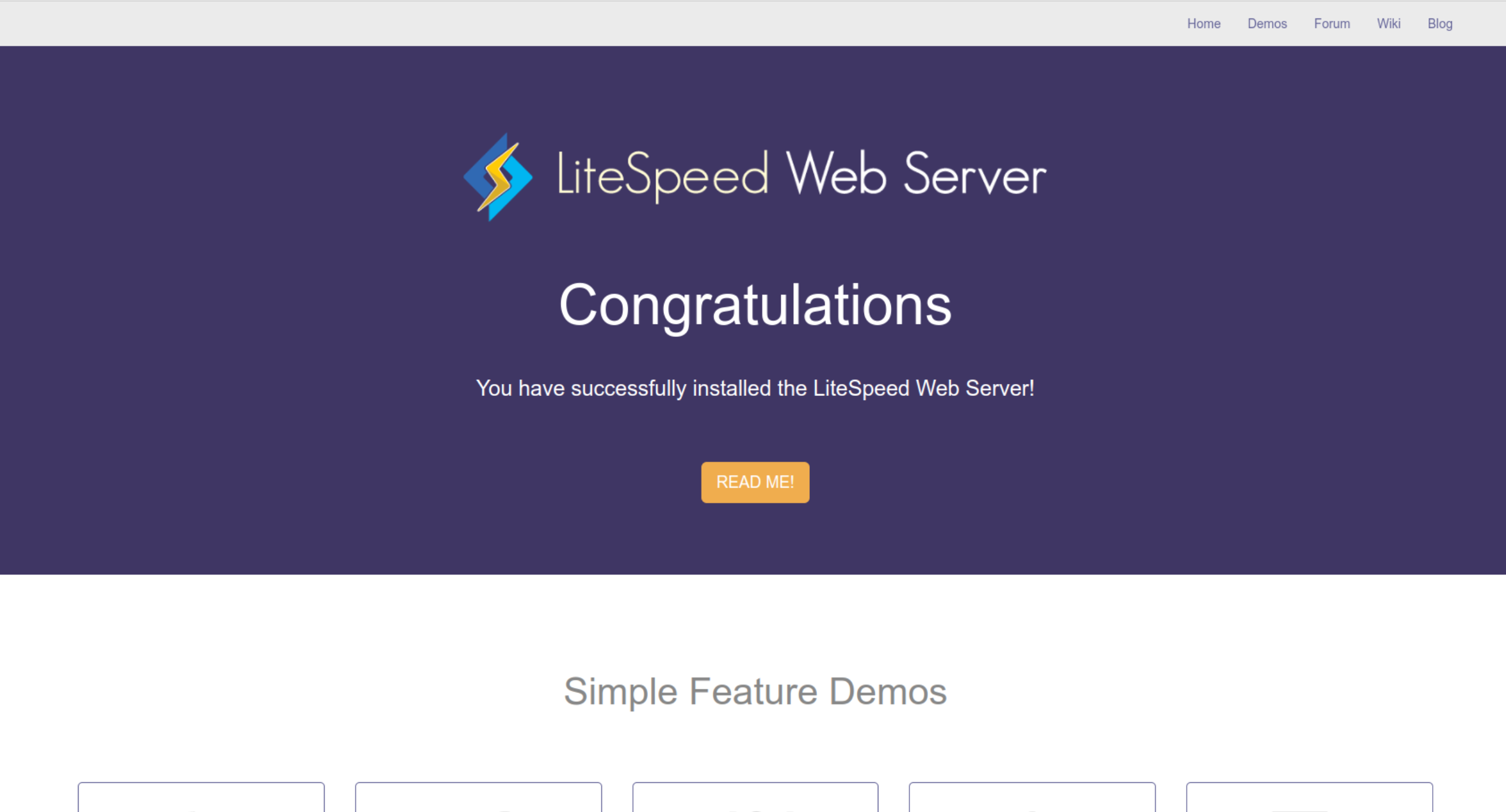
You can look around the example website to explore the features offered by the web server.
To see the GUI-based Admin Panel, access port 7080:
http://your_server_ip:7080
You will likely see a page warning you that the SSL certificate from the server cannot be validated. Because this is a self-signed certificate, this message is expected. Click through the available options to proceed to the site. In Chrome, you must click Advanced and then Proceed to… .
You will be prompted to enter the administrative username and password that you selected with the admpass.sh script in the previous step:
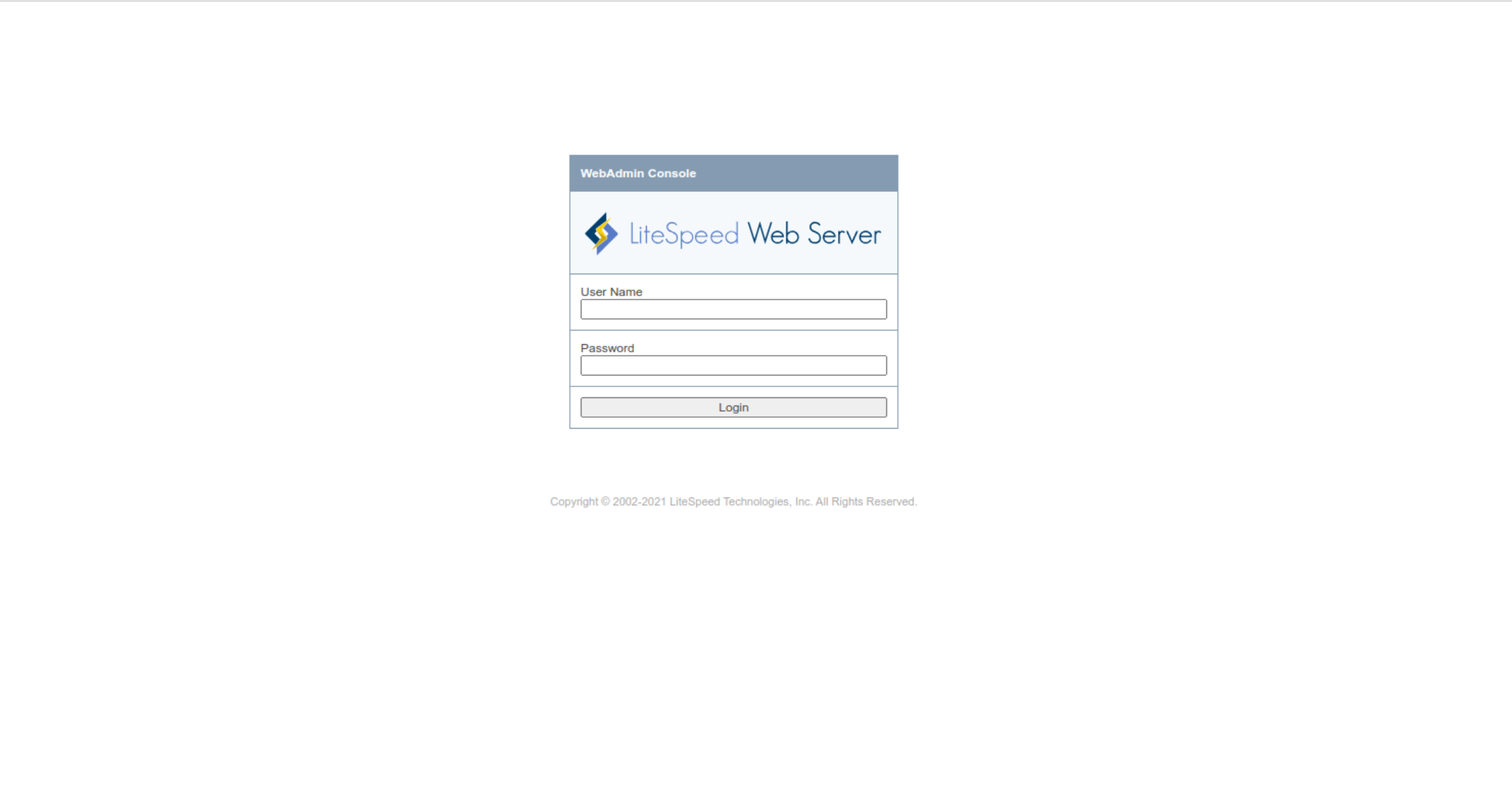
Once authenticated, you will be presented with the LiteSpeed administration interface:
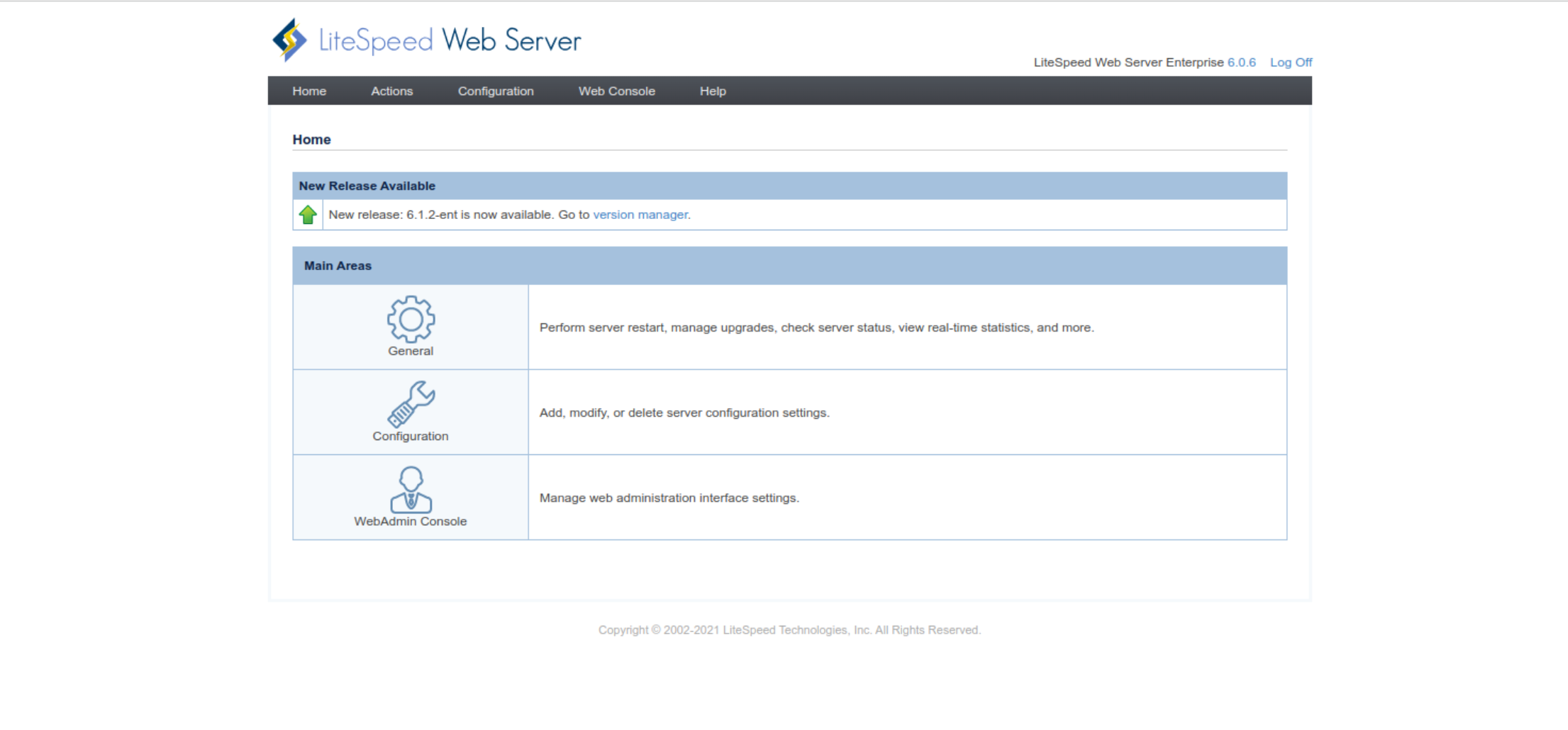
The majority of your configuration for the web server will take place via this dashboard.
2. Install some Utility packagesPermalink
apt install -y git wget curl unzip nano zip
2.a. PHP 8.1+Permalink
First add this PPA repository:
add-apt-repository ppa:ondrej/php
Then install php 8.1 with these extensions:
apt update
apt install -y php8.1 libapache2-mod-php8.1 php8.1-mysql \
php8.1-cli php8.1-common php8.1-fpm php8.1-soap php8.1-gd \
php8.1-opcache php8.1-mbstring php8.1-zip \
php8.1-bcmath php8.1-intl php8.1-xml php8.1-curl \
php8.1-imap php8.1-ldap php8.1-gmp php8.1-redis
2.b. Setting Up IonCubePermalink
wget http://downloads3.ioncube.com/loader_downloads/ioncube_loaders_lin_x86-64.tar.gz
tar xvfz ioncube_loaders_lin_x86-64.tar.gz
Copy the ion-cube loader to Directory. Replace your yourpath below with actual path that was shown with the output of first command below, and restart the both nginx and php.
php -i | grep extension_dir
cp ioncube/ioncube_loader_lin_8.1.so /usr/lib/php/'replaceyourpath'
sed -i '2 a zend_extension = "/usr/lib/php/'replaceyourpath'/ioncube_loader_lin_8.1.so"' /etc/php/8.1/fpm/php.ini
sed -i '2 a zend_extension = "/usr/lib/php/'replaceyourpath'/ioncube_loader_lin_8.1.so"' /etc/php/8.1/cli/php.ini
systemctl restart lsws
systemctl restart php8.1-fpm
2.c. MySQLPermalink
The official Faveo installation uses Mysql as the database system and this is the only official system we support. While Laravel technically supports PostgreSQL and SQLite, we can’t guarantee that it will work fine with Faveo as we’ve never tested it. Feel free to read Laravel’s documentation on that topic if you feel adventurous.
Install Mysql 8.0 or MariaDB 10.6. Note that this only installs the package, but does not setup Mysql. This is done later in the instructions:
For Ubuntu 18.04Permalink
sudo apt update
sudo apt install software-properties-common -y
curl -LsS -O https://downloads.mariadb.com/MariaDB/mariadb_repo_setup
sudo bash mariadb_repo_setup --mariadb-server-version=10.6
sudo apt update
sudo apt install mariadb-server mariadb-client
sudo systemctl enable mariadb
For Ubuntu 20.04Permalink
sudo apt install dirmngr ca-certificates software-properties-common gnupg gnupg2 apt-transport-https curl -y
curl -fsSL http://repo.mysql.com/RPM-GPG-KEY-mysql-2022 | gpg --dearmor | sudo tee /usr/share/keyrings/mysql.gpg > /dev/null
echo 'deb [signed-by=/usr/share/keyrings/mysql.gpg] http://repo.mysql.com/apt/ubuntu focal mysql-8.0' | sudo tee -a /etc/apt/sources.list.d/mysql.list
echo 'deb-src [signed-by=/usr/share/keyrings/mysql.gpg] http://repo.mysql.com/apt/ubuntu focal mysql-8.0' | sudo tee -a /etc/apt/sources.list.d/mysql.list
sudo apt update
sudo apt install mysql-community-server -y
sudo systemctl start mysql
sudo systemctl enable mysql
For Ubuntu 22.04Permalink
sudo apt update
sudo apt install mariadb-server mariadb-client -y
sudo systemctl start mariadb
sudo systemctl enable mariadb
Secure your MySql installation by executing the below command. Set Password for mysql root user, remove anonymous users, disallow remote root login, remove the test databases and finally reload the privilege tables.
mysql_secure_installation
phpMyAdmin(Optional): Install phpMyAdmin. This is optional step. phpMyAdmin gives a GUI to access and work with Database
apt install phpmyadmin
2.d. Install wkhtmltopdfPermalink
Wkhtmltopdf is an open source simple and much effective command-line shell utility that enables user to convert any given HTML (Web Page) to PDF document or an image (jpg, png, etc).
It uses WebKit rendering layout engine to convert HTML pages to PDF document without losing the quality of the pages. Its is really very useful and trustworthy solution for creating and storing snapshots of web pages in real-time.
For Ubuntu 18.04 and 20.04Permalink
apt-get -y install wkhtmltopdf
For Ubuntu 22.04Permalink
echo "deb http://security.ubuntu.com/ubuntu focal-security main" | sudo tee /etc/apt/sources.list.d/focal-security.list
apt-get update; apt install libssl1.1 -y
wget https://github.com/wkhtmltopdf/packaging/releases/download/0.12.6-1/wkhtmltox_0.12.6-1.focal_amd64.deb
dpkg -i wkhtmltox_0.12.6-1.focal_amd64.deb
apt --fix-broken install -y
Once the softwares above are installed:
3. Upload FaveoPermalink
For Faveo Freelancer, Paid and Enterprise VersionPermalink
Please download Faveo Helpdesk from https://billing.faveohelpdesk.com and upload it to below directory
Navigate to the virtual host root which is /usr/local/lsws/Example/html
cd /usr/local/lsws/DEFAULT/html
mkdir faveo
Extracting the Faveo-Codebase zip filePermalink
unzip "faveo.zip" -d faveo
For Faveo Community VersionPermalink
You may install Faveo by simply cloning the repository. In order for this to work with Apache, you need to clone the repository in a specific folder:
cd /usr/local/lsws/DEFAULT/html
git clone https://github.com/ladybirdweb/faveo-helpdesk.git faveo
You should check out a tagged version of Faveo since master branch may not always be stable. Find the latest official version on the release page
Give proper permissions to the project directory by running:You should check out a tagged version of Faveo since master branch may not always be stable. Find the latest official version on the release page
Give proper permissions to the project directory by running:
chown -R nobody:nogroup faveo
cd faveo
find . -type f -exec chmod 644 {} \;
find . -type d -exec chmod 755 {} \;
4. Configure Litespeed webserverPermalink
4.a. LSPHP 8.1+Permalink
LiteSpeed hosts its code on its own repository. Add this repository to the apt package manager’s sources list with the following command:
sudo wget -O - https://repo.litespeed.sh | sudo bash
Update the list of repositories to ensure that the newly added repository is scanned by the apt package manager:
sudo apt update
Next, install the litespeed package:
sudo apt install lsphp81 lsphp81-curl lsphp81-imap lsphp81-mysql lsphp81-ldap lsphp81-redis lsphp81-ioncube
Configuring LSPHP 8.1
Via http://your_server_ip:7080, log in to the Admin Panel (using the credentials you just set up) and navigate to the Server Configuration section. Then, click the External App tab.

You will see the following screen:

Here, you can configure your server to use any specific PHP processor. For this tutorial, we will use lsphp81.
- Name:
lsphp81 - Address:
uds://tmp/lshttpd/lsphp80.sock - Max Connections:
35 - Environment:
PHP_LSAPI_MAX_REQUESTS=50 PHP_LSAPI_CHILDREN=35 LSAPI_AVOID_FORK=200M - Initial Request Timeout (secs):
60 - Retry Timeout :
0 - Persistent Connection:
Yes - DEFAULT Response Buffering:
no - DEFAULT Start By Server:
Yes(Through CGI Daemon) - Command:
$SERVER_ROOT/lsphp81/bin/lsphp - Back Log:
100 - Instances:
1 - Priority:
0 - Memory Soft Limit (bytes):
2047M - Memory Hard Limit (bytes):
2048M - Process Soft Limit:
1400 - Process Hard Limit:
1500
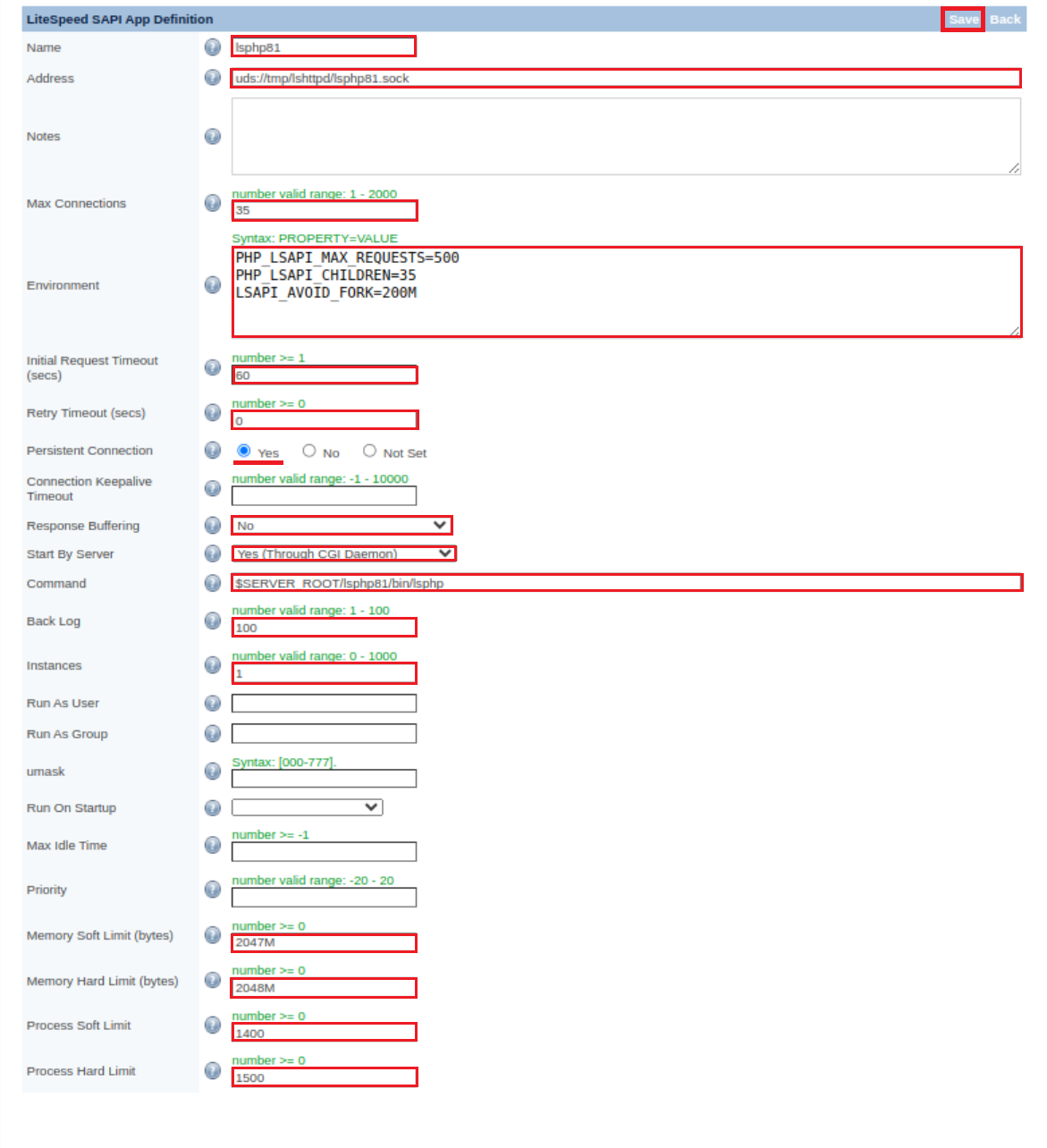
navigate to the Server Configuration section. Then, click the Script Handler tab.

- Suffixes:
php81 - Handler Type:
Litespedd SAPI - Handler Name:
[Server Level]: lsphp81
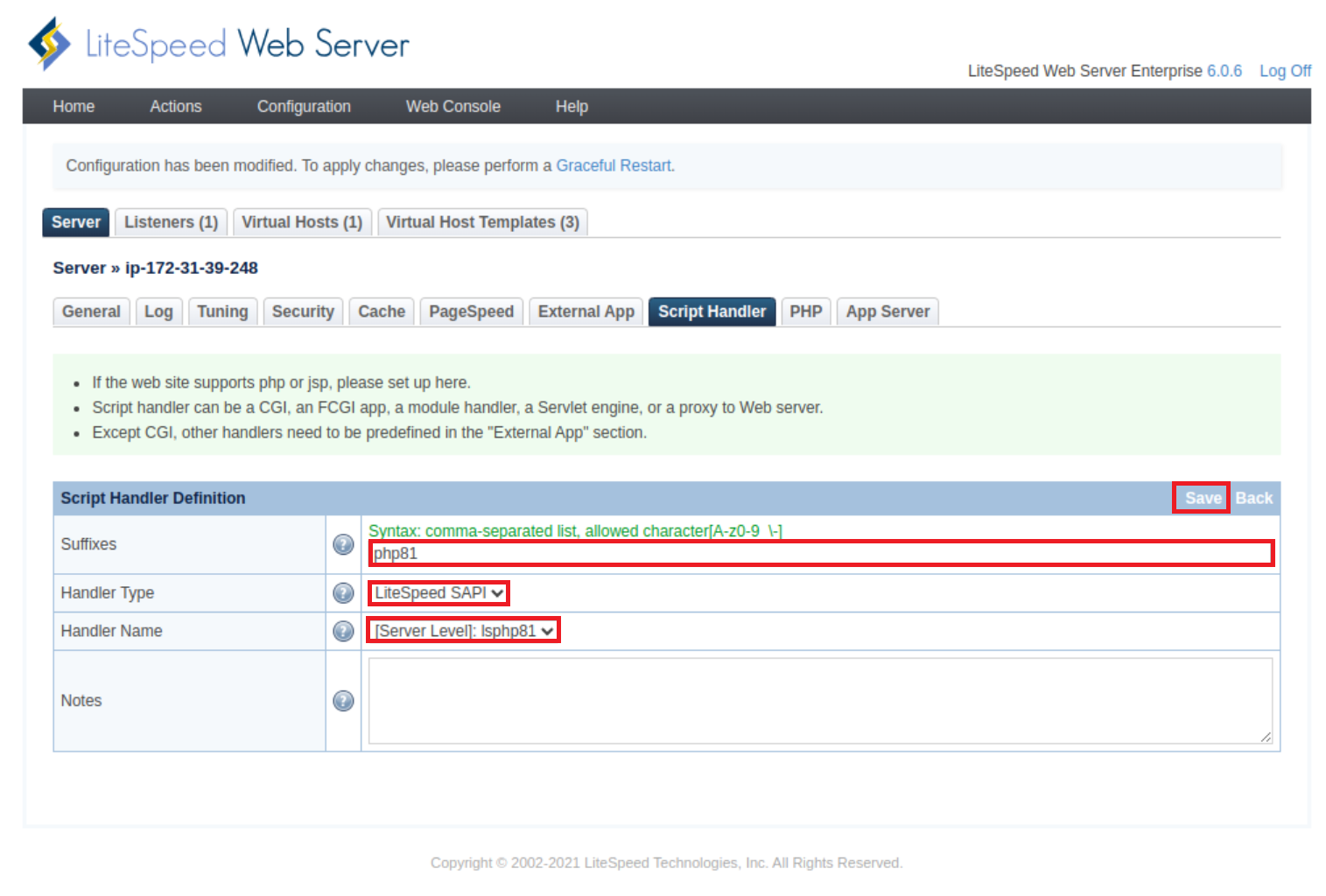
Then, click the PHP tab. Edit PHP Global Configuration.
- Detached Mode:
Yes - Control Panel:
Litespedd Native
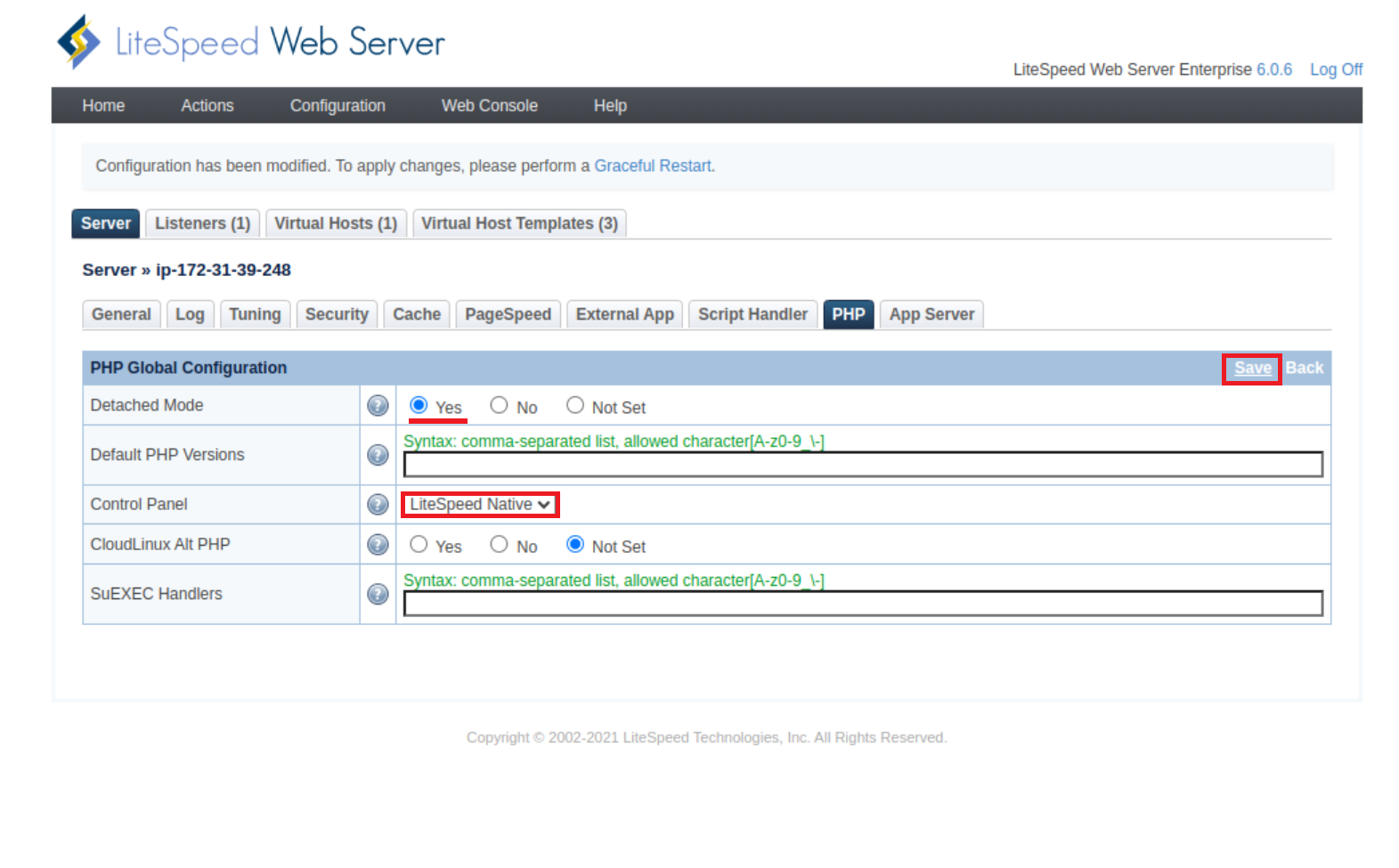
Then, Edit PHP Handler Definition.
- Handler ID:
php81 - Command:
$SERVER_ROOT/lsphp81/bin/lsphp - Handler Suffixes:
php

Use the Graceful Restart button in the top right to restart the web server. The Graceful Restart button is highlighted in the upper right of the following screencapture:
Verify that your server is now using the specified PHP version by visiting the informational page at port 80:
http://your_server_ip/phpinfo.php
After installing LSPHP 8.1, run the commands below to open PHP default config file.
nano /usr/local/lsws/lsphp81/etc/php/8.1/litespeed/php.ini
Then make the changes on the following lines below in the file and save. The value below are great settings to apply in your environment.
file_uploads = On
allow_url_fopen = On
short_open_tag = On
memory_limit = 256M
cgi.fix_pathinfo = 0
upload_max_filesize = 100M
post_max_size = 100M
max_execution_time = 360
4.b Setting Up a Virtual HostPermalink
Moving next to configure the rewrite module which is an essential requirement for the WordPress features. Go to the Virtual Hosts and click on the view icon.
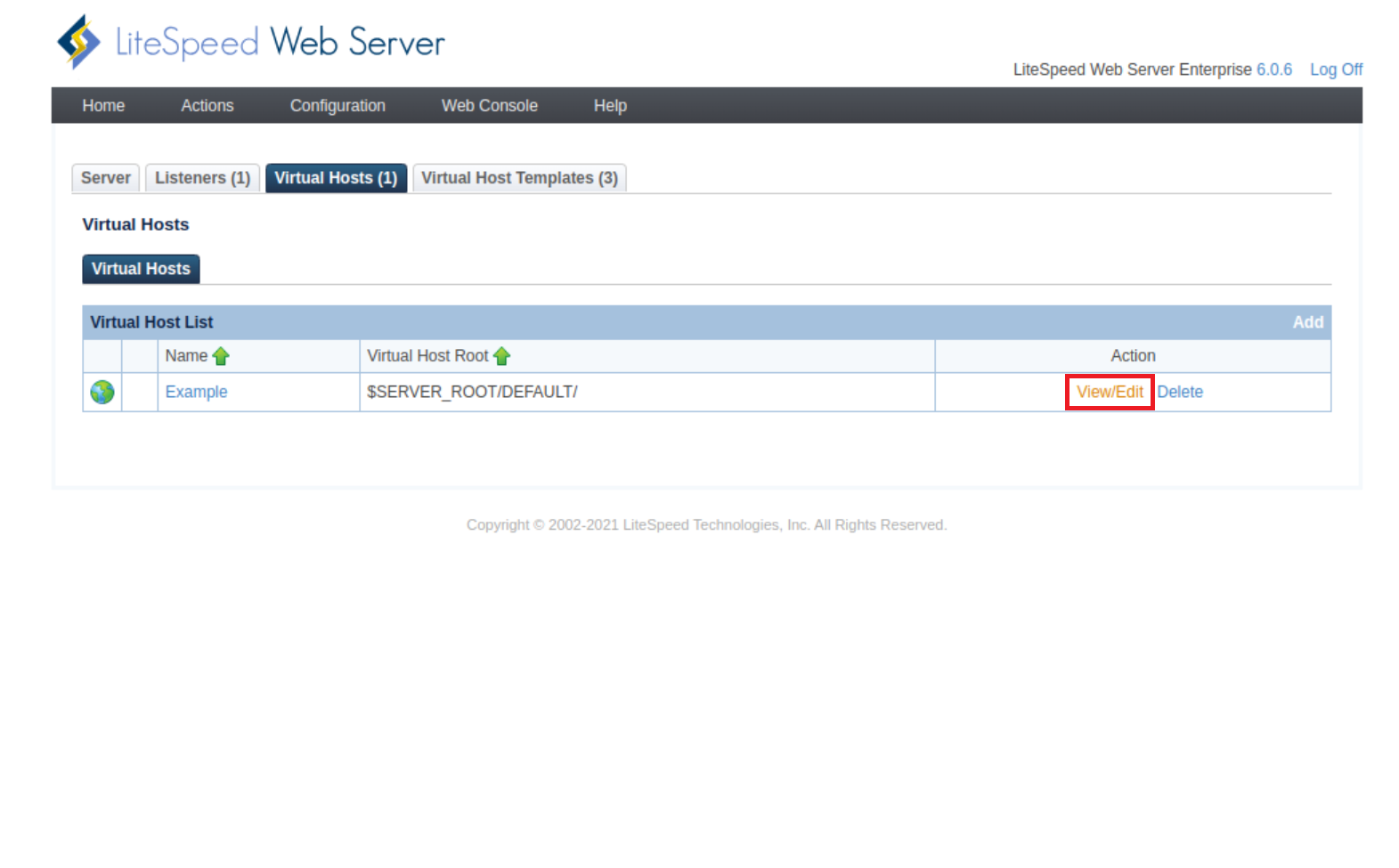
Click on the General tab and edit the General options with the edit icon at the top right corner.
In the Document Root field, type $VH_ROOT/html/faveo
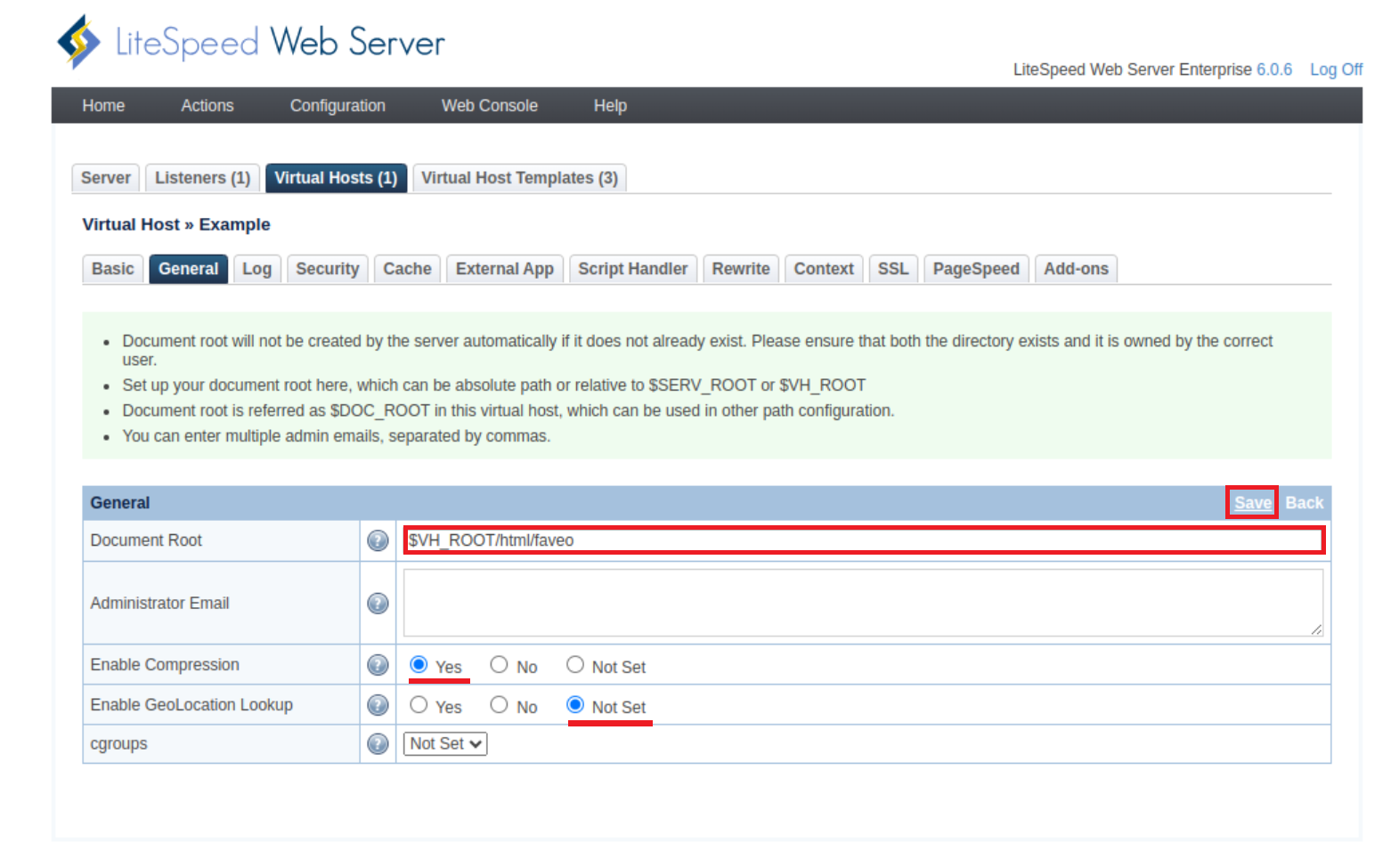
Then again on the General tab of Virtual Hosts configuration, click the edit icon next to the Index Files section.
In the Index Files field, add index.php at the beginning of the section. Then click the save button at the top right corner.
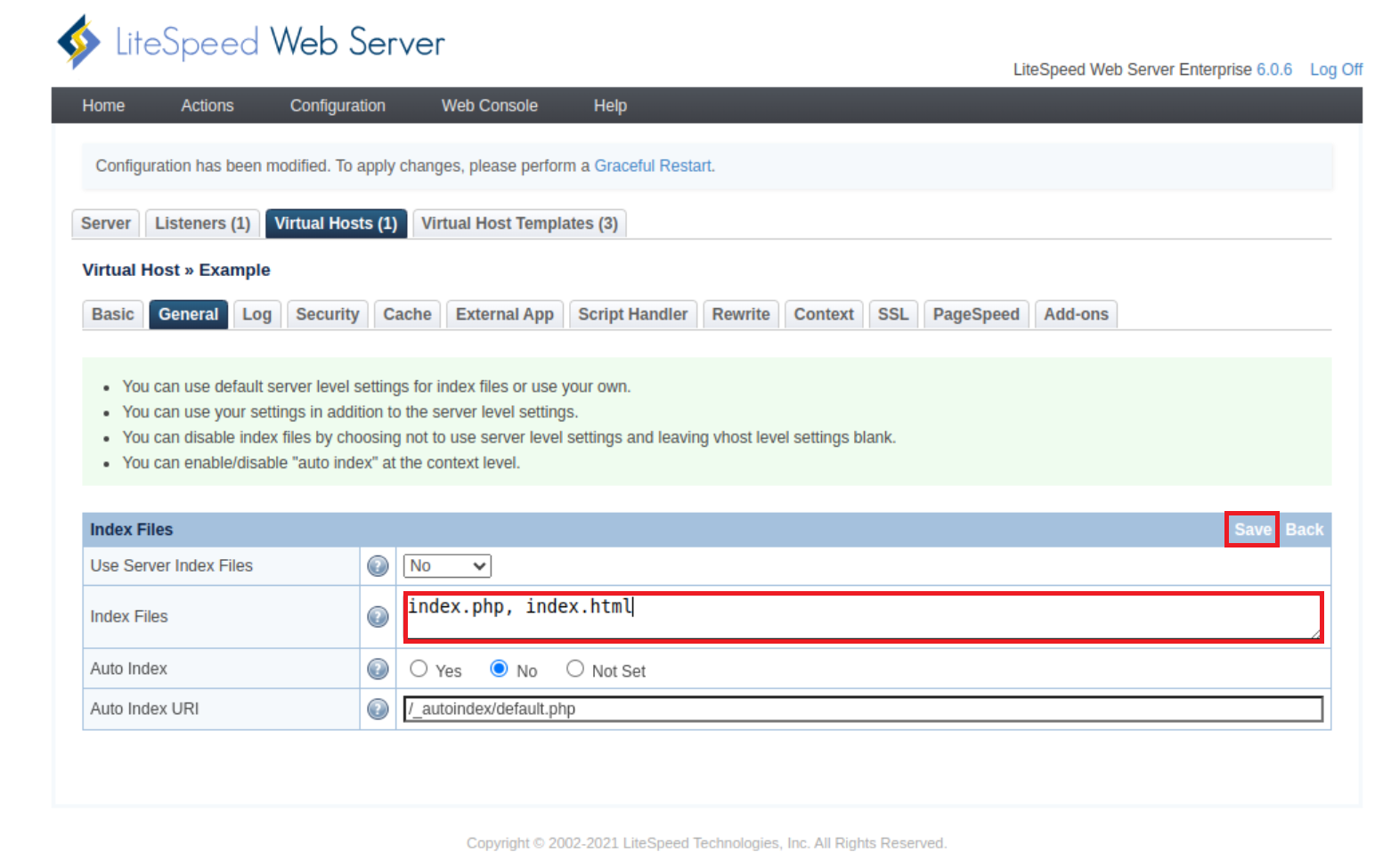
Then again on the General tab of Virtual Hosts configuration, click the edit icon next to the ht access section.
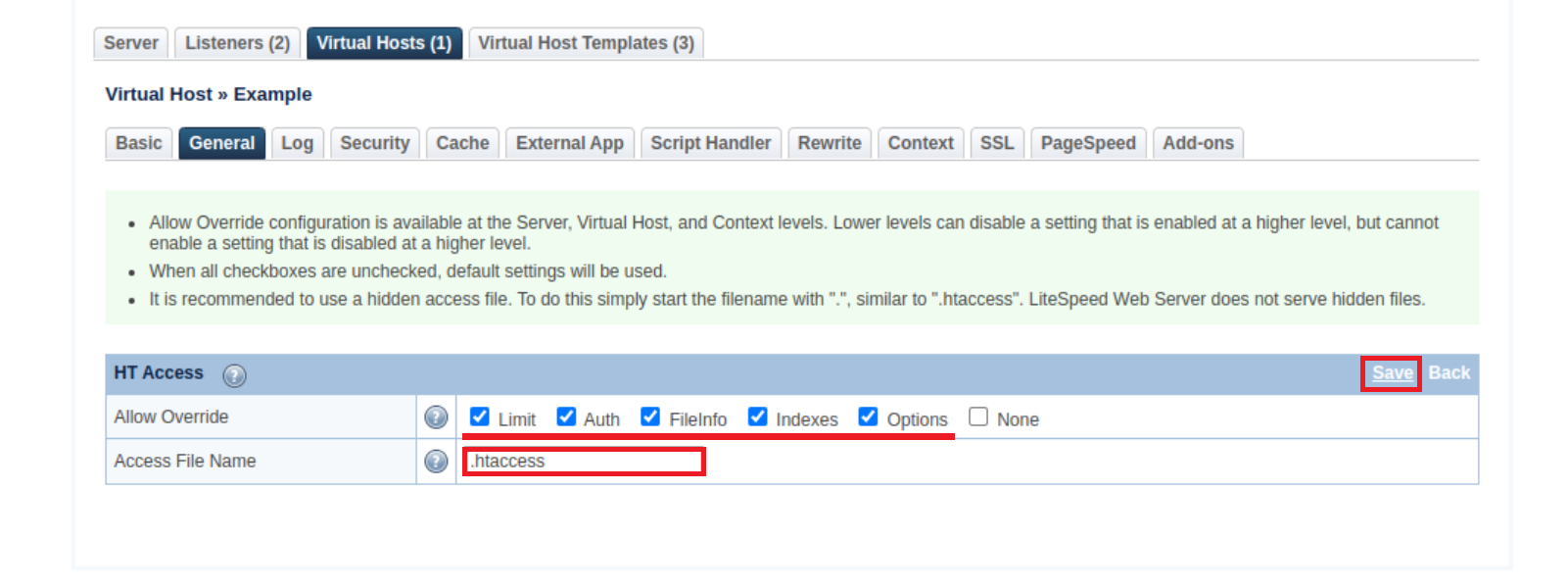
Next, go to the Script Handler tab of the Virtual Hosts configuration view and edit the Script Handler Definition options.
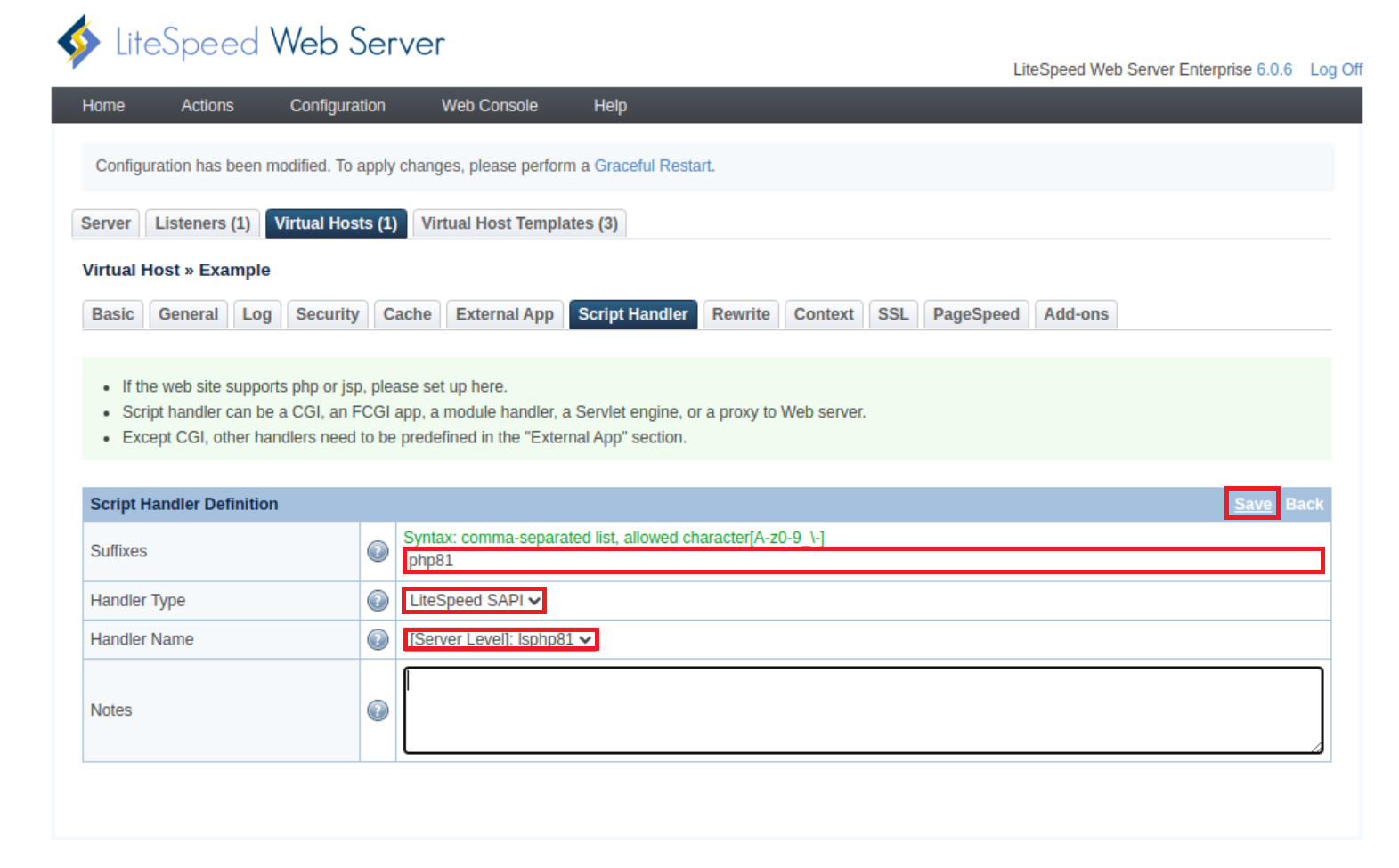
Next, go to the Rewrite tab of the Virtual Hosts configuration view and edit the Rewrite Control options.
Set Enable Rewrite and Auto Load from .htaccess to Yes and click the save icon at the top right corner.
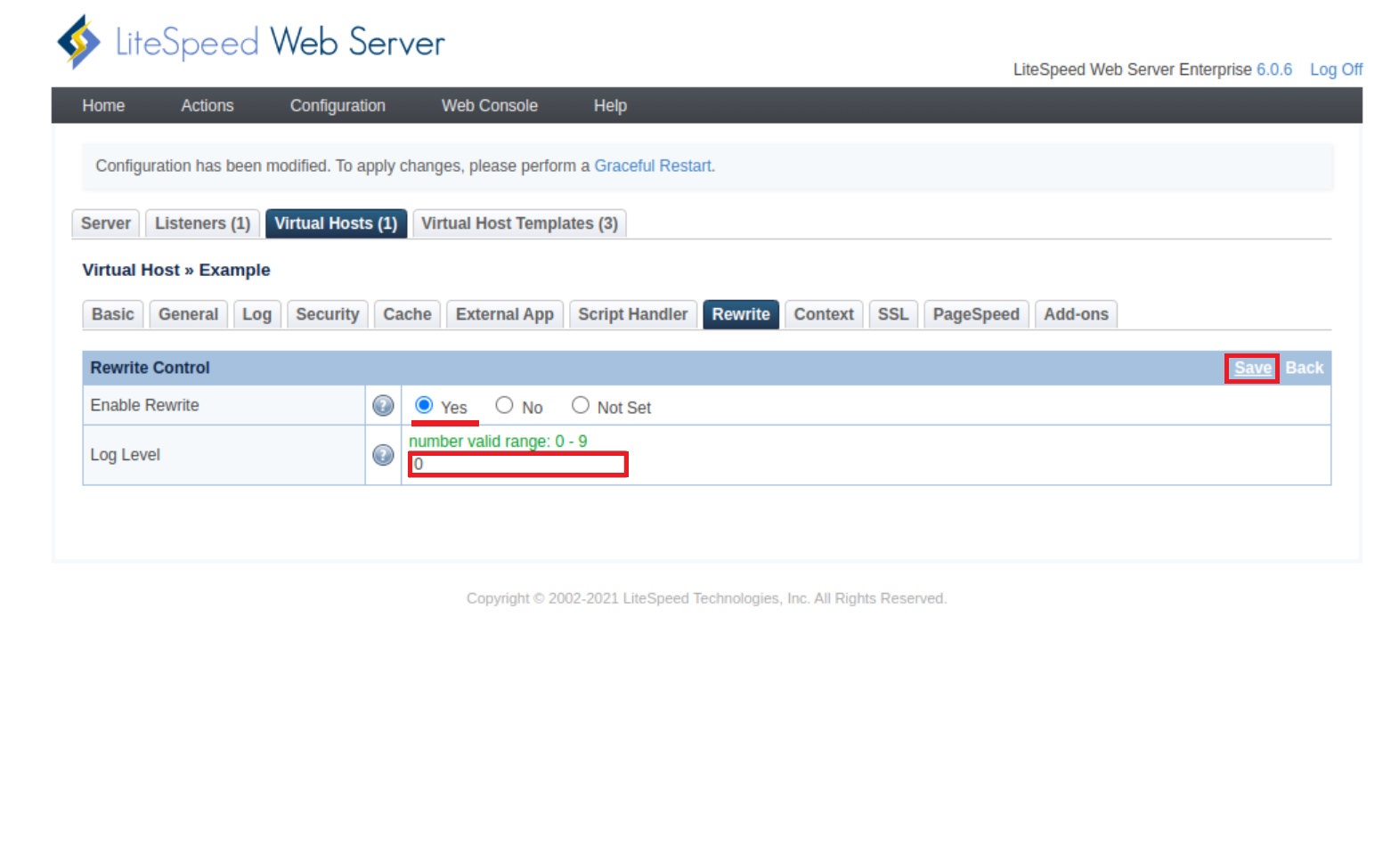
Once you’ve configured the litespeed server, Click the gracefully restart icon to apply the changes.
5. Setup the databasePermalink
Log in with the root account to configure the database.
mysql -u root -p
Create a database called ‘faveo’.
CREATE DATABASE faveo;
Create a user called ‘faveo’ and its password ‘strongpassword’.
CREATE USER 'faveo'@'localhost' IDENTIFIED BY 'strongpassword';
We have to authorize the new user on the faveo db so that he is allowed to change the database.
GRANT ALL ON faveo.* TO 'faveo'@'localhost';
And finally we apply the changes and exit the database.
FLUSH PRIVILEGES;
exit
6. SSL InstallationPermalink
Secure Sockets Layer (SSL) is a standard security technology for establishing an encrypted link between a server and a client. Let’s Encrypt is a free, automated, and open certificate authority.
Faveo Requires HTTPS so the SSL is a must to work with the latest versions of faveo, so for the internal network and if there is no domain for free you can use the Self-Signed-SSL.
Let’s Encrypt SSL installation documentation
7. Configure cron jobPermalink
Faveo requires some background processes to continuously run. Basically those crons are needed to receive emails To do this, setup a cron that runs every minute that triggers the following command php artisan schedule:run.Verify your php ececutable location and replace it accordingly in the below command.
sudo crontab -e
* * * * * /usr/bin/php -q /usr/local/lsws/Example/html/faveo/artisan schedule:run 2>&1
sudo crontab -l
8. Redis InstallationPermalink
Redis is an open-source (BSD licensed), in-memory data structure store, used as a database, cache and message broker.
This is an optional step and will improve system performance and is highly recommended.
Redis installation documentation
9. Install FaveoPermalink
At this point if the domainname is propagated properly with your server’s IP you can open Faveo in browser just by entering your domainname. You can also check the Propagation update by Visiting this site www.whatsmydns.net.
Now you can install Faveo via GUI Wizard or CLI
10. Faveo BackupPermalink
At this stage, Faveo has been installed, it is time to setup the backup for Faveo File System and Database. Follow this article to setup Faveo backup.
11. Final stepPermalink
The final step is to have fun with your newly created instance, which should be up and running to http://localhost or the domain you have configured Faveo with.